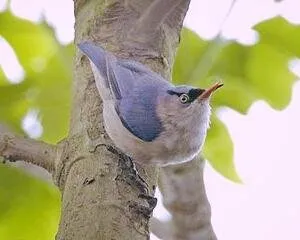Kalakapala Banmali (Scientific name:


The middle tree of a species belonging to the tribe or family belongs to Sitta (City). [2] [3] Kalamapala Banmali's scientific name means
Birds like frosted woodpeckers (Greek:
sitte = birds like woodpecker, Latin:
frontalis = eyebrows). [3] The bird
Bangladesh, India, is seen in different countries of South and Southeast Asia. They live in a large area around the world, some 500,000,000 square kilometers. [4] Over the past few decades, their number has decreased, but has not reached the alarming stage. That's why I U. C. N. This species has been declared a Least Concern or the least risk. [1]
This species is preserved in Wildlife Act of Bangladesh. [3]
Expansion and sub-species
Bangladesh, India, Bhutan, Nepal,
Sri Lanka, Myanmar, Laos, Brunei,
Cambodia, China, Indonesia,
Philippines, Malaysia, Singapore,
Thailand and Vietnam Kalamapala Banmali's main residence. The five subspecies of this species were found. They are:
- S. f. frontalis (Swainson, 1820) - Hills of India (Ganges delta,
Deccan, except north and northwestern districts), from Kumaon to Assam and Nagaland on the foothills of Himalayas, Bangladesh, Sri Lanka, South China, Myanmar, Thailand and Indochina. - S. f. saturatior (E. J. O. Hartert, 1902) -
Malay Peninsula, Singapore, Lingua Islands, Sumatra and Banika - S. f corallipes (Sharpe, 1888) - Multiple islands in Borneo and adjoining areas
- S. f. palawana (E. J. O. Hartert, 1905) - West Philippines
- S. f. velata (Temminck, 1821) - Java. [5]
Description
Kalkapala Banmali Red Lip Small Nilak Bird The bird's length is only 10 centimeters, the wing is 8 cm, the lips are 2.2 cm, the legs are 2 cm, the tail is 4.3 cm and the weight is 24 grams. [3] Adult bird's back is purple-blue; The flight feathers are black, the dusk dark blue. The middle of the throat and throat is white. The flame remains light, some brown brown. The velvet velvet is on the forehead, with black stout spots in front of the eye. There is no black spot on the wife's spine. Both the eyes and eyes of both the wife and the male bird yellow in the eye. The brownish red, upper part of the upper part of the chestnut brown, the feet and feet of the feet, potato brown. [6] The toes of the feet are orange-yellow. Minorous bird's lips are full of orange peatav in the dark gray and relatively gray gray. [3]
Behavior and Eating
Kalkapala Banamali mainly walks in Paraban. It is seen in leafy and evergreen forests. Usually wanders in pairs or small family groups. Usually fly in the main tree of the tree. They fly from inside the forest and eat old food of the bark and the old trees of the trees, they are very hungry. At a very quick pace, jumping on the tree trunk and flying on the other tree. There are insects and larvae in the diet. They are very brave in the trees and they move up and down. Typically, during the meal, a chit or seat sit in the seat. [6]
Reproduction
They make small houses by spreading shawlas, furts and feathers in summer during the summer (January-May). Two to six reddish white egg lay eggs. Egg size is 1.7 × 1.3 cm [3] Men and wives make eggs in the egg.
[6] Eggs in 14-16 days. Leave home for 15 days.# ****


